Stormwater Quality and Long-Term Efficiency Capturing Potential Toxic Elements in Sustainable Urban Drainage Systems—Is the Soil Quality of Bio-Swales after 10–20 Years Still Acceptable?
Abstract
1. Introduction
Typical Bio-Swales in The Netherlands
2. Materials and Methods
2.1. Mapping Bio-Swales
2.2. Database of Stormwater Quality
2.3. Selection of Bio-Swale Locations
2.4. In Situ Measurements of Potential Toxic Elements (PETs) with Portable XRF
3. Results and Discussion
3.1. ClimateScan as a Toolbox
3.2. The Stormwater Database
3.3. Are the Oldest Bio-Swales Most Polluted?
3.4. pXRF Mapping
4. Conclusions
Author Contributions
Funding
Institutional Review Board Statement
Informed Consent Statement
Data Availability Statement
Acknowledgments
Conflicts of Interest
References
- Calvin, K.; Dasgupta, D.; Krinner, G.; Mukherji, A.; Thorne, P.W.; Trisos, C.; Romero, J.; Aldunce, P.; Barrett, K.; Blanco, G.; et al. IPCC, 2023: Climate Change 2023: Synthesis Report. Contribution of Working Groups I, II and III to the Sixth Assessment Report of the Intergovernmental Panel on Climate Change; Core Writing Team, Lee, H., Romero, J., Eds.; IPCC: Geneva, Switzerland, 2023. [Google Scholar]
- Rahman, Z.; Singh, V.P. The Relative Impact of Toxic Heavy Metals (THMs) (Arsenic (As), Cadmium (Cd), Chromium (Cr) (VI), Mercury (Hg), and Lead (Pb)) on the Total Environment: An Overview. Environ. Monit. Assess. 2019, 191, 419. [Google Scholar] [CrossRef] [PubMed]
- Huber, M.; Welker, A.; Helmreich, B. Critical Review of Heavy Metal Pollution of Traffic Area Runoff: Occurrence, Influencing Factors, and Partitioning. Sci. Total Environ. 2016, 541, 895–919. [Google Scholar] [CrossRef] [PubMed]
- McKenzie, E.R.; Money, J.E.; Green, P.G.; Young, T.M. Metals Associated with Stormwater-Relevant Brake and Tire Samples. Sci. Total Environ. 2009, 407, 5855–5860. [Google Scholar] [CrossRef] [PubMed]
- Folkeson, L.; Bækken, T.; Brenčič, M.; Dawson, A.; Frančois, D.; Kuřímská, P.; Leitão, T.; Ličbinský, R.; Vojtěšek, M. Sources and Fate of Water Contaminants in Roads. In Water in Road Structures. Geotechnical, Geological and Earthquake Engineering; Springer: Dordrecht, The Netherlands, 2009; pp. 107–146. [Google Scholar]
- Stagge, J.H.; Davis, A.P.; Jamil, E.; Kim, H. Performance of Grass Swales for Improving Water Quality from Highway Runoff. Water Res. 2012, 46, 6731–6742. [Google Scholar] [CrossRef]
- Kong, Z.; Shao, Z.; Shen, Y.; Zhang, X.; Chen, M.; Yuan, Y.; Li, G.; Wei, Y.; Hu, X.; Huang, Y.; et al. Comprehensive Evaluation of Stormwater Pollutants Characteristics, Purification Process and Environmental Impact after Low Impact Development Practices. J. Clean. Prod. 2021, 278, 123509. [Google Scholar] [CrossRef]
- Boogaard, F. Stormwater Characteristics and New Testing Methods for Certain Sustainable Urban Drainage Systems in The Netherlands; TU Delft: Delft, The Netherlands, 2015; ISBN 978-94-6259-745-7. [Google Scholar]
- Davis, A.P.; Traver, R.G.; Hunt, W.F.; Lee, R.; Brown, R.A.; Olszewski, J.M. Hydrologic Performance of Bioretention Storm-Water Control Measures. J. Hydrol. Eng. 2012, 17, 604–614. [Google Scholar] [CrossRef]
- Brown, J.N.; Peake, B.M. Sources of Heavy Metals and Polycyclic Aromatic Hydrocarbons in Urban Stormwater Runoff. Sci. Total Environ. 2006, 359, 145–155. [Google Scholar] [CrossRef] [PubMed]
- Charters, F.J.; Cochrane, T.A.; O’Sullivan, A.D. The Influence of Urban Surface Type and Characteristics on Runoff Water Quality. Sci. Total Environ. 2021, 755, 142470. [Google Scholar] [CrossRef]
- Balderas Guzman, C.; Wang, R.; Muellerklein, O.; Smith, M.; Eger, C.G. Comparing Stormwater Quality and Watershed Typologies across the United States: A Machine Learning Approach. Water Res. 2022, 216, 118283. [Google Scholar] [CrossRef]
- UNEP Partnership for Clean Fuels and Vehicles. 2022. Available online: https://www.unep.org/topics/transport/partnership-clean-fuels-and-vehicles/lead-campaign (accessed on 16 March 2024).
- Chen, T.; Wang, M.; Su, J.; Li, J. Unlocking the Positive Impact of Bio-Swales on Hydrology, Water Quality, and Biodiversity: A Bibliometric Review. Sustainability 2023, 15, 8141. [Google Scholar] [CrossRef]
- Boogaard, F.; van de Ven, F.; Langeveld, J.; van de Giesen, N. Stormwater Quality Characteristics in (Dutch) Urban Areas and Performance of Settlement Basins. Challenges 2014, 5, 112–122. [Google Scholar] [CrossRef]
- Leroy, M.C.; Marcotte, S.; Legras, M.; Moncond’huy, V.; Le Derf, F.; Portet-Koltalo, F. Influence of the Vegetative Cover on the Fate of Trace Metals in Retention Systems Simulating Roadside Infiltration Swales. Sci. Total Environ. 2017, 580, 482–490. [Google Scholar] [CrossRef]
- Tedoldi, D.; Chebbo, G.; Pierlot, D.; Kovacs, Y.; Gromaire, M.-C. Impact of Runoff Infiltration on Contaminant Accumulation and Transport in the Soil/Filter Media of Sustainable Urban Drainage Systems: A Literature Review. Sci. Total Environ. 2016, 569–570, 904–926. [Google Scholar] [CrossRef]
- Kluge, B.; Markert, A.; Facklam, M.; Sommer, H.; Kaiser, M.; Pallasch, M.; Wessolek, G. Metal Accumulation and Hydraulic Performance of Bioretention Systems after Long-Term Operation. J. Soils Sediments 2018, 18, 431–441. [Google Scholar] [CrossRef]
- Dechesne, M.; Barraud, S.; Bardin, J.-P. Spatial Distribution of Pollution in an Urban Stormwater Infiltration Basin. J. Contam. Hydrol. 2004, 72, 189–205. [Google Scholar] [CrossRef]
- Dierkes, C.; Geiger, W. Pollution Retention Capabilities of Roadside Soils. Water Sci. Technol. 1999, 39, 201–208. [Google Scholar] [CrossRef]
- Revitt, D.M.; Ellis, J.B.; Lundy, L. Assessing the Impact of Swales on Receiving Water Quality. Urban Water J. 2017, 14, 839–845. [Google Scholar] [CrossRef]
- Gavrić, S.; Leonhardt, G.; Österlund, H.; Marsalek, J.; Viklander, M. Metal Enrichment of Soils in Three Urban Drainage Grass Swales Used for Seasonal Snow Storage. Sci. Total Environ. 2021, 760, 144136. [Google Scholar] [CrossRef] [PubMed]
- Jiang, Y.; Yuan, Y.; Piza, H. A Review of Applicability and Effectiveness of Low Impact Development/Green Infrastructure Practices in Arid/Semi-Arid United States. Environments 2015, 2, 221–249. [Google Scholar] [CrossRef]
- Davis, A.P. Field Performance of Bioretention: Water Quality. Environ. Eng. Sci. 2007, 24, 1048–1064. [Google Scholar] [CrossRef]
- Kabir, M.I.; Daly, E.; Maggi, F. A Review of Ion and Metal Pollutants in Urban Green Water Infrastructures. Sci. Total Environ. 2014, 470–471, 695–706. [Google Scholar] [CrossRef] [PubMed]
- Horstmeyer, N.; Huber, M.; Drewes, J.E.; Helmreich, B. Evaluation of Site-Specific Factors Influencing Heavy Metal Contents in the Topsoil of Vegetated Infiltration Swales. Sci. Total Environ. 2016, 560–561, 19–28. [Google Scholar] [CrossRef] [PubMed]
- Li, H.; Davis, A.P. Heavy Metal Capture and Accumulation in Bioretention Media. Environ. Sci. Technol. 2008, 42, 5247–5253. [Google Scholar] [CrossRef] [PubMed]
- Tedoldi, D.; Chebbo, G.; Pierlot, D.; Kovacs, Y.; Gromaire, M.-C. Assessment of Metal and PAH Profiles in SUDS Soil Based on an Improved Experimental Procedure. J. Environ. Manag. 2017, 202, 151–166. [Google Scholar] [CrossRef] [PubMed]
- Kalnicky, D.J.; Singhvi, R. Field Portable XRF Analysis of Environmental Samples. J. Hazard. Mater. 2001, 83, 93–122. [Google Scholar] [CrossRef] [PubMed]
- Simmons, K.; Deatrick, J.; Johnson, H. Field X-ray Fluorescence Measuring. SESD Operating Procedure SESDPROC-107-R3; U.S. Environmental Protection Agency: Washington, DC, USA, 2015.
- STOWA Stormwater Quality in The Netherlands (in Dutch: Kwaliteit Afstromend Hemelwater in Nederland. Database Kwaliteit Afstromend Hemelwater). 2020. Drukkerij Modern: Bennekom, The Netherlands, 2020; ISBN 9789057738845. Available online: https://www.stowa.nl/publicaties/kwaliteit-afstromend-hemelwater-nederland-database-kwaliteit-afstromend-hemelwater (accessed on 16 March 2024).
- Ballard, B.W.; Wilson, S.; Udale-Clarke, H.; Illman, S.; Scott, T.; Ashley, R.; Kellagher, R. The SUDS Manual; CIRIA: London, UK, 2017; ISBN 978-0-86017-697-8. [Google Scholar]
- Beral, H.; Dagenais, D.; Brisson, J.; Kõiv-Vainik, M. Plant Species Contribution to Bioretention Performance under a Temperate Climate. Sci. Total Environ. 2023, 858, 160122. [Google Scholar] [CrossRef]
- Restemeyer, B.; Boogaard, F.C. Potentials and Pitfalls of Mapping Nature-Based Solutions with the Online Citizen Science Platform Climatescan. Land 2021, 10, 5. [Google Scholar] [CrossRef]
- Venvik, G.; Boogaard, F.C. Portable XRF Quick-Scan Mapping for Potential Toxic Elements Pollutants in Sustainable Urban Drainage Systems: A Methodological Approach. Sci 2020, 2, 64. [Google Scholar] [CrossRef]
- NMHSPE 2000 Circular on Target Values and Intervention Values for Soil Remediation. The Netherlands Ministry of Housing, Spatial Planning and the Environment, Amsterdam. 2000. Available online: https://www.esdat.net/Environmental%20Standards/Dutch/annexS_I2000Dutch%20Environmental%20Standards.pdf (accessed on 5 March 2024).
- Maestre, A.; Pitt, R.E. Stormwater Databases: NURP, USGS, International BMP Database and NSQD. J. Water Manag. Model. 2007, 15, R227-20. [Google Scholar] [CrossRef][Green Version]
- Brombach, H.; Weiss, G.; Fuchs, S. A New Database on Urban Runoff Pollution: Comparison of Separate and Combined Sewer Systems. Water Sci. Technol. 2005, 51, 119–128. [Google Scholar] [CrossRef]
- Allen, P.A. Sediment Routing Systems; Cambridge University Press: Cambridge, UK, 2017; ISBN 9781107091993. [Google Scholar]
- Boogaard, F.; Liefting, E.; Langeveld, J.; Palsma, B. Dutch Stormwater Quality (in Dutch: De Kwaliteit van Afstromend Hemelwater in Nederland). H20 2020, 4. Available online: https://www.h2owaternetwerk.nl/vakartikelen/de-kwaliteit-van-afstromend-hemelwater-in-nederland (accessed on 5 March 2024).
- Boogaard, F.C. RIONED Swales: Recommendations for Design, Implementation and Maintenance (in Dutch: Wadi’s: Aanbevelingen Voor Ontwerp, Aanleg En Beheer); RIONED: Ede, The Netherlands, 2016; ISBN 9073645220. [Google Scholar]
- Tedoldi, D.; Chebbo, G.; Pierlot, D.; Branchu, P.; Kovacs, Y.; Gromaire, M.-C. Spatial Distribution of Heavy Metals in the Surface Soil of Source-Control Stormwater Infiltration Devices—Inter-Site Comparison. Sci. Total Environ. 2017, 579, 881–892. [Google Scholar] [CrossRef] [PubMed]
- Reimann, C.; Fabian, K.; Flem, B. Cadmium Enrichment in Topsoil: Separating Diffuse Contamination from Biosphere-Circulation Signals. Sci. Total Environ. 2019, 651, 1344–1355. [Google Scholar] [CrossRef] [PubMed]
- Langeveld, J.G.; Cherqui, F.; Tscheikner-Gratl, F.; Muthanna, T.M.; Juarez, M.F.-D.; Leitão, J.P.; Roghani, B.; Kerres, K.; do Céu Almeida, M.; Werey, C.; et al. Asset Management for Blue-Green Infrastructures: A Scoping Review. Blue-Green Syst. 2022, 4, 272–290. [Google Scholar] [CrossRef]
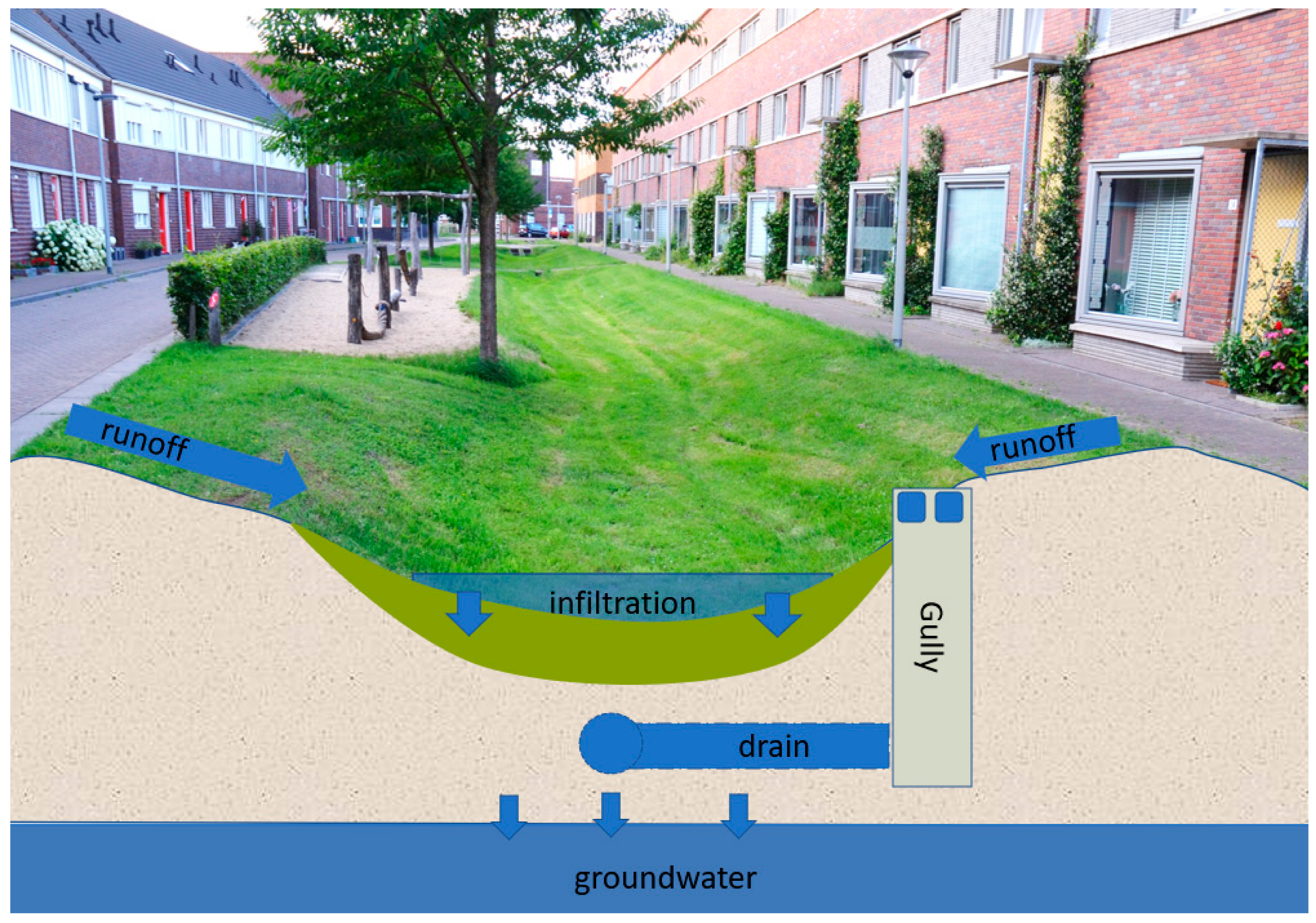

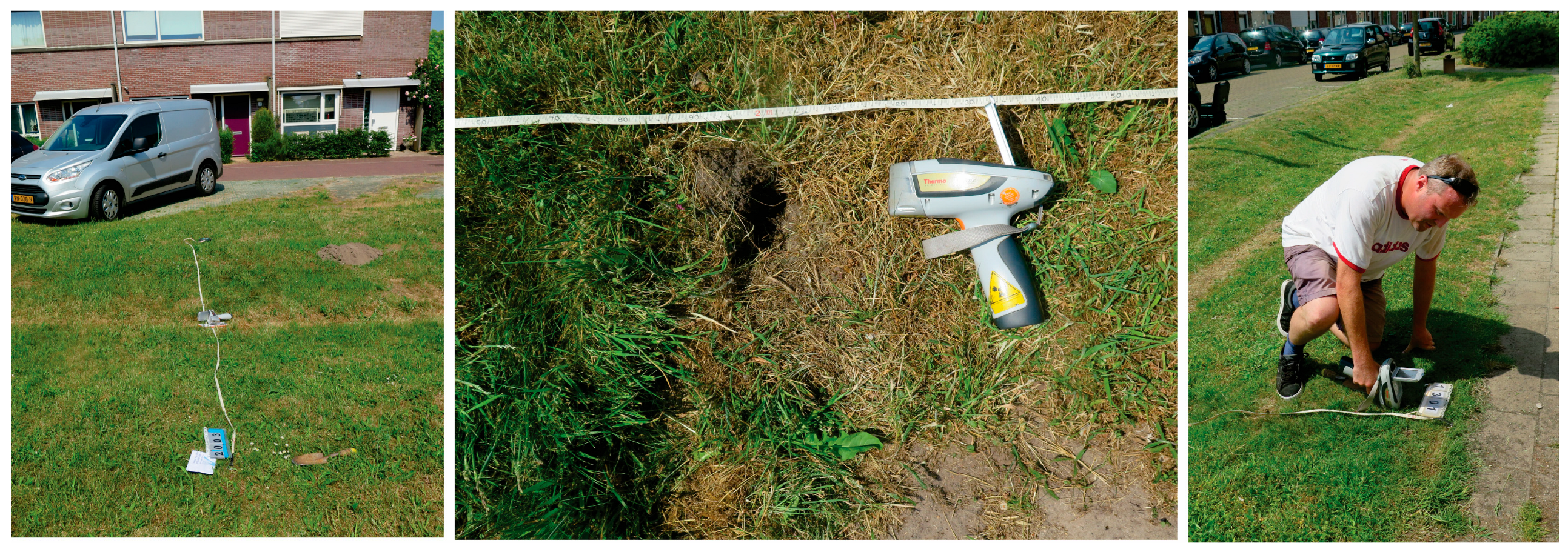
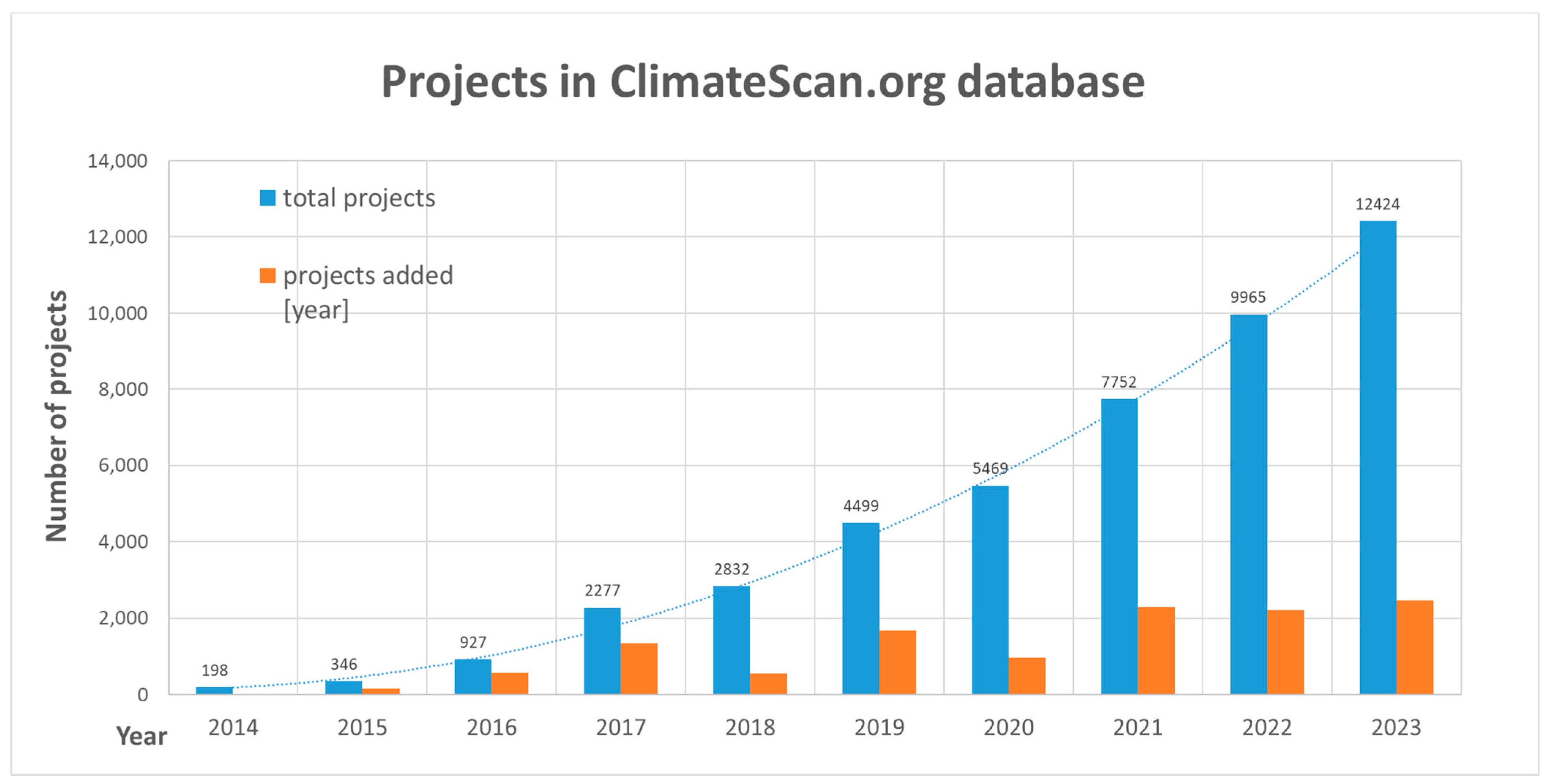
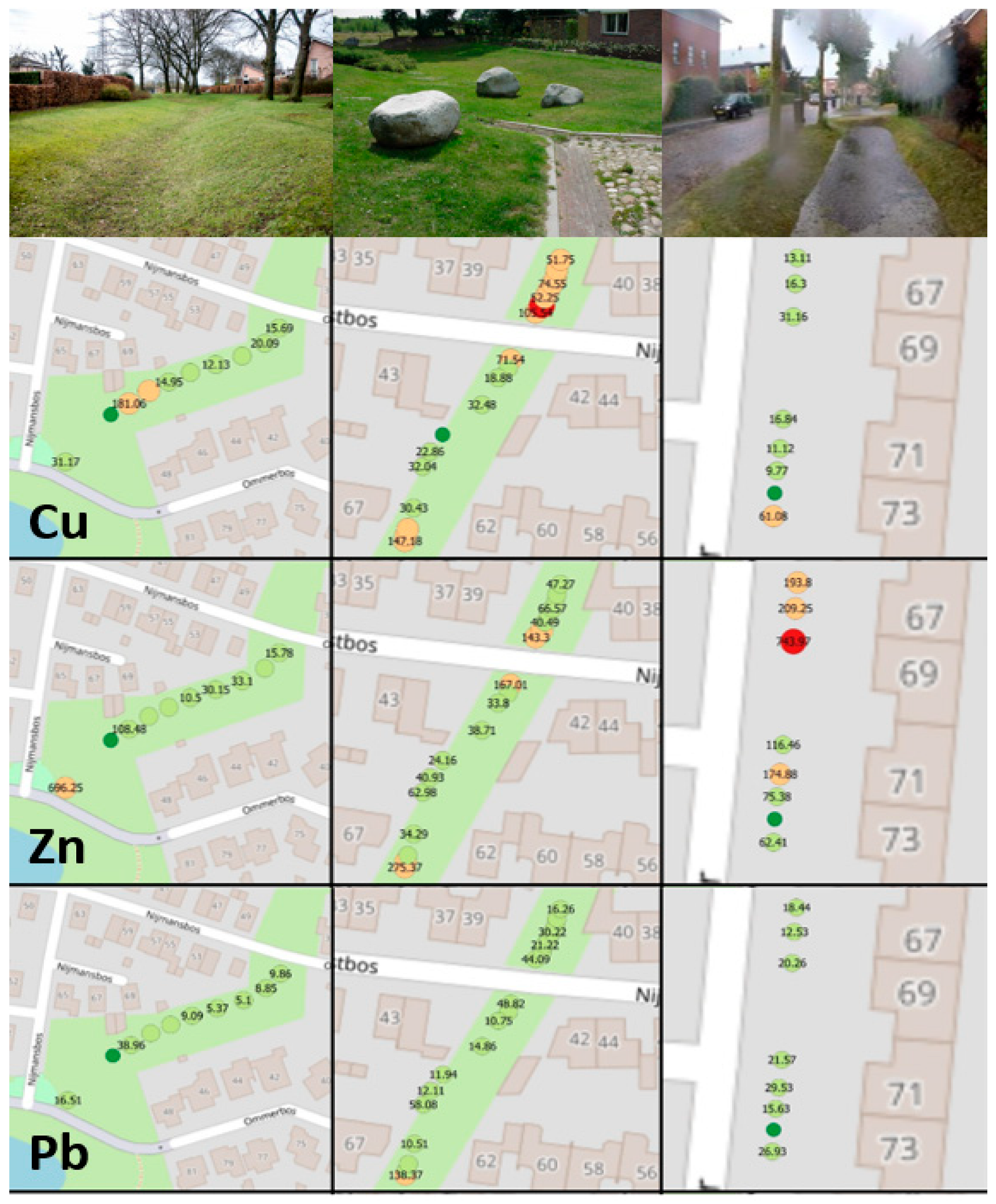
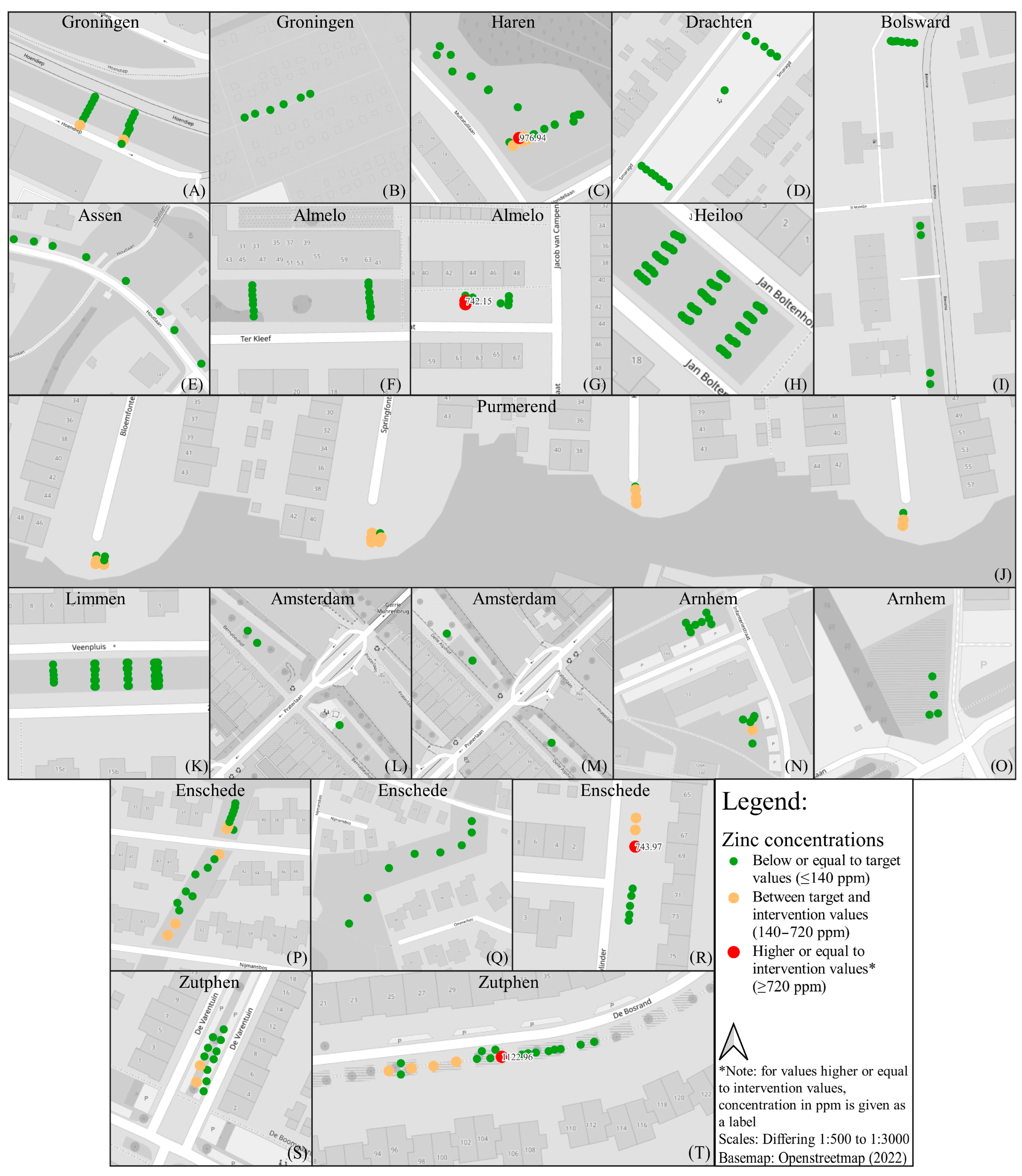
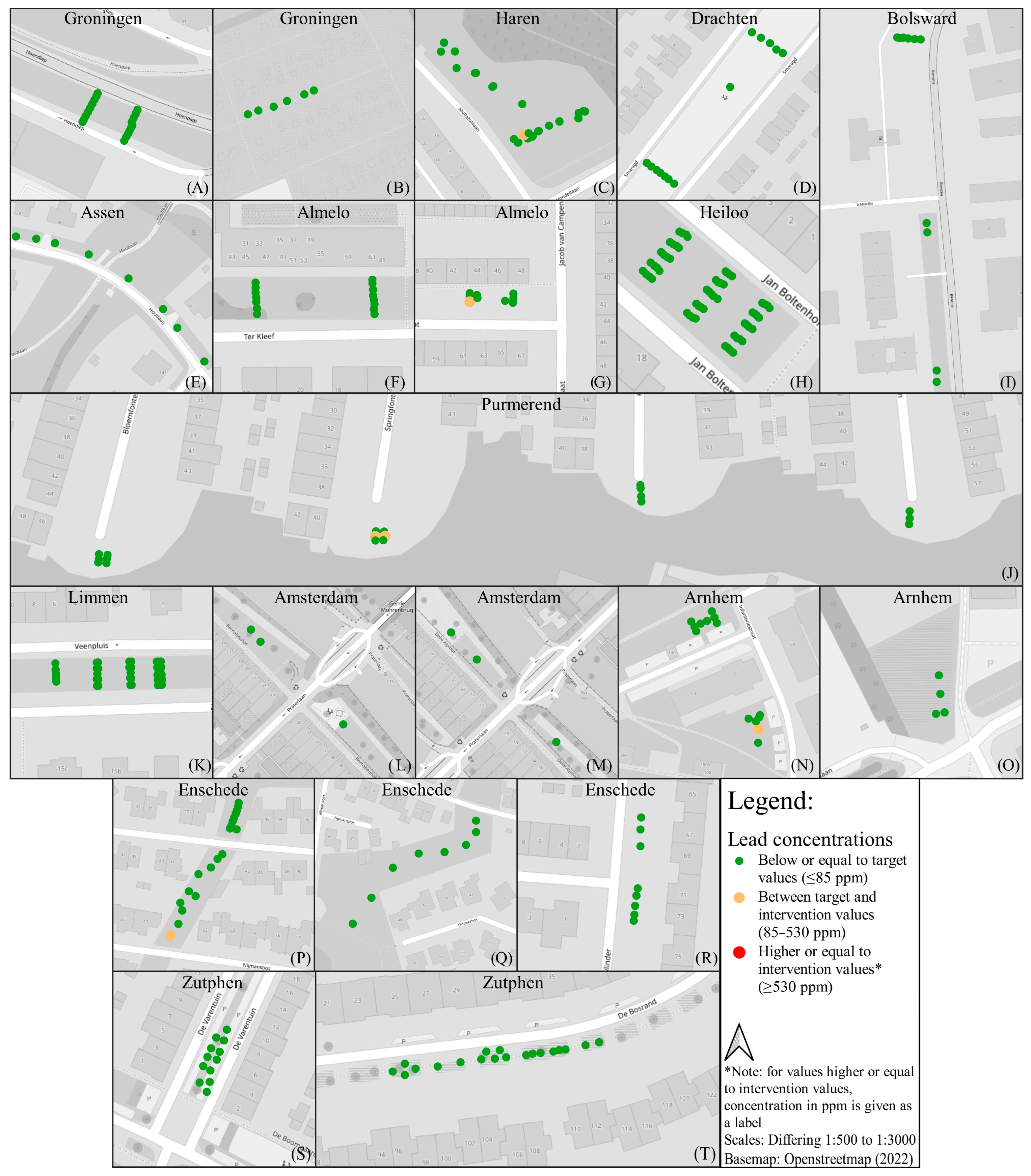
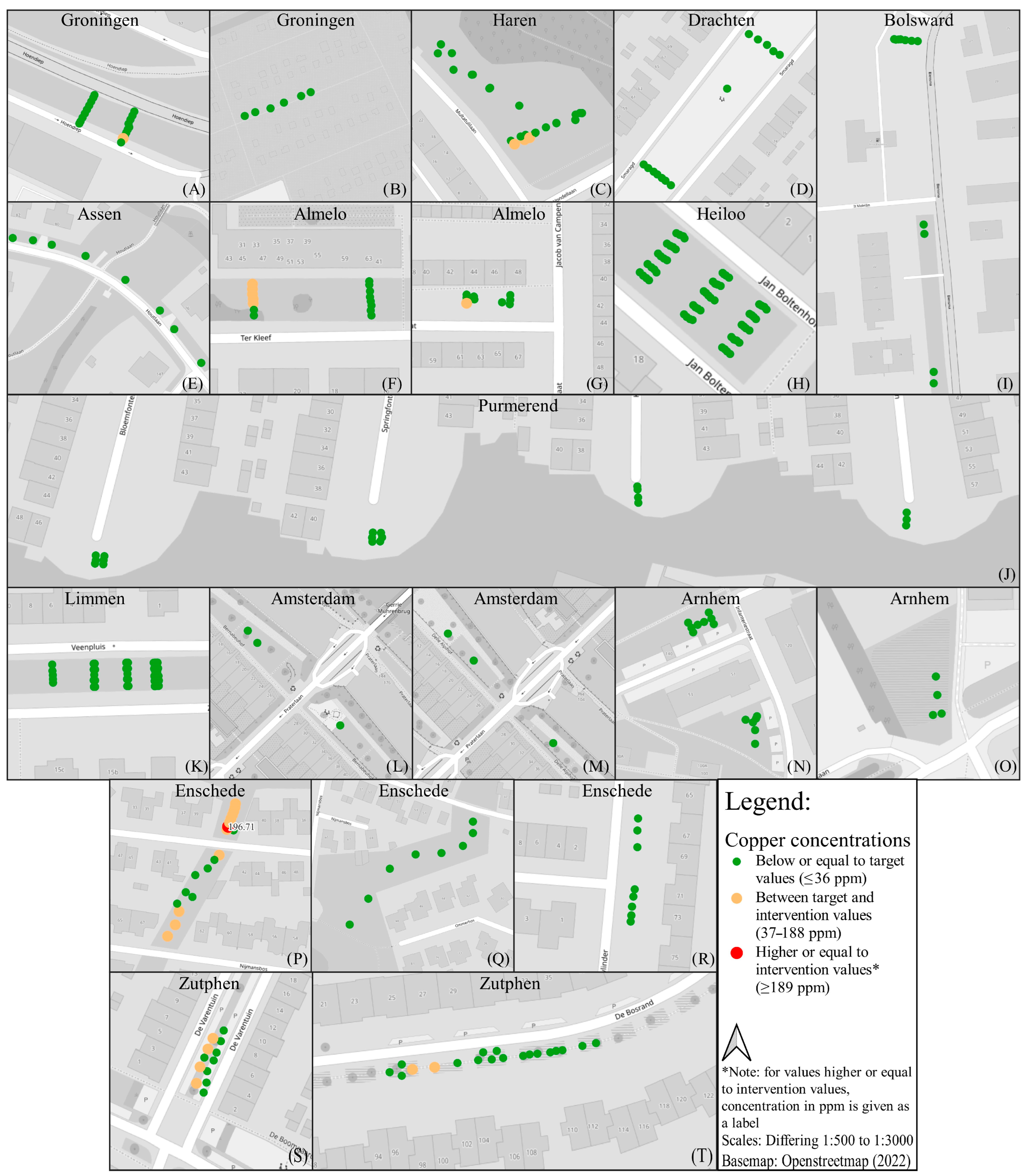
| Design Parameter | Unit | Value |
|---|---|---|
| Water depth | m | 0.3–0.5 |
| Width bottom | m | >0.5 |
| Slope | 1:n | 1:3 |
| Thickness of top layer (for filtration) | m | >0.3 |
| Humus in top layer | % | 3–5 |
| Infiltration capacity Kd | m/day | >0.5 |
| Time to empty | h | <48 |
| Vegetation | - | Grass with high vegetation cover |
| PT Elements | Target Value ppm (mg/kg) | Intervention Value ppm (mg/kg) |
|---|---|---|
| Lead (Pb) | 85 | 530 |
| Zinc (Zn) | 140 | 720 |
| Copper (Cu) | 36 | 190 |
| Parameter | The Netherlands (Rural) Stormwater Quality RIVM: 2012–2018 | The Netherlands (Stormwater Database) | USA NSQD Overall | USA NSQD Residential | Germany ATV Database |
|---|---|---|---|---|---|
| Literature | [31] | [31] | [37] | [37] | [38] |
| Average (D10–D90) * | Average (D10–D90) * | Median n = number | Median n = number | Median | |
| Copper (Cu) [μg/L] MAC = maximum allowed concentration available (dissolved concentration) | Average 2.1 50–90% 1.1–4.5 N = 603 | Average 28 50–90% 18–60 N = 183 | 16 n = 2724 | 12 n = 799 | 48 |
| Lead (Pb) [μg/L] MAC = 14 | Average 0.93 50–90% 0.6–1.9 N = 619 | Average 12 50–90% 4.6–32 N = 183 | 17 n = 2950 | 12 n = 788 | 118 |
| Zinc (Zn) [μg/L] MAC = 15.6 | Average 8.2 50–90% 4.8–17 N = 617 | Average 183 50–90% 74–256 N = 183 | 117 n = 3008 | 73 n = 810 | 275 |
| TSS [mg/L] | Average 56 50–90% 20–181 N = 114 | 58 n = 3390 | 49 n = 991 | 141 |
| Location | Building Age (Majority of Adjacent Buildings) | Usage of Buildings | Roof Type | Adjacent Road Type | Other Relevant Adjacencies | Total Number of Measurements (xrf) | Zn > 140 ppm | Zn > 720 ppm (Highest ppm) | Cu > 36 ppm | Cu > 190 ppm (Highest ppm) | Pb > 85 ppm | Pb > 530 ppm |
|---|---|---|---|---|---|---|---|---|---|---|---|---|
| Lieven de Keystraat | 1959 | Housing | Tiles | Brick | Parking next to measurement | 10 | 2 | 2 (742) | 1 | 0 | 1 | 0 |
| Ter Kleef | 1975 | Housing | Flat roof, bitumen, grit | Brick | Gardens on boundary of measurement | 15 | 0 | 0 | 4 | 0 | 0 | 0 |
| Delle Alpihof | 2002 | Housing | Flat roofs with bitumen and Grit | Paving | N.A. | 3 | 0 | 0 | 0 | 0 | 0 | 0 |
| Bernabeuhof | 2002 | Housing | Flat roof, bitumen, grit | Paving | N.A. | 3 | 0 | 0 | 0 | 0 | 0 | 0 |
| Beukenlaan | 1935–1952 | Housing, sport facility, greenhouse | Tiles, flat roofs, bitumen | Brick | Parking next to measurement | 4 | 0 | 0 | 0 | 0 | 0 | 0 |
| Infanteriestraat | 1939–2016 | Mixed used, housing, offices | Tiles | Brick | Parking next to measurement | 14 | 2 | 0 | 0 | 0 | 1 | 0 |
| Houtlaan | 2001–2004 | Housing | Tiles | Brick | N.A. | 8 | 0 | 0 | 0 | 0 | 0 | 0 |
| Smaragd | 2005–2006 | Housing | Flat roof, corrugated metal, bitumen | Brick | N.A. | 13 | 0 | 0 | 0 | 0 | 0 | 0 |
| Mastbos Red | 1997 | Housing | Tiles | Brick | Gardens on boundary of measurement | 8 | 0 | 0 | 0 | 0 | 0 | 0 |
| Mastbos Green | 1998 | Housing | Tiles | Brick | Gardens on boundary of measurement | 19 | 4 | 0 | 10 | 1 (197) | 1 | 0 |
| Oikos | 2005 | Housing | Tiles | Brick | N.A. | 8 | 3 | 1 (742) | 0 | 0 | 0 | 0 |
| Hoendiep | 1970–1991 | Industry | Flat roof, bitumen | Asphalt | Next to a main road | 19 | 2 | 0 | 1 | 0 | 0 | 0 |
| Snip | N.A. | Garden houses and sheds | Tiles and flat roofs with bitumen | Dirt | Gardens on boundary of measurement | 10 | 0 | 0 | 0 | 0 | 0 | 0 |
| Bolsward | 2001–2003 | Industry | Flat roofs with bitumen | Asphalt | Next to a main road | 11 | 0 | 0 | 0 | 0 | 0 | 0 |
| Vondellaan | 1969–1968 | Housing | Flat roofs with bitumen and grit | Asphalt | Next to a main road | 21 | 5 | 2 (977) | 2 | 0 | 1 | 0 |
| Jan Boltenhof Egelshoek | 2000 | Housing | Flat roofs with bitumen and grit | Brick | Parking next to measurement | 61 | 0 | 0 | 0 | 0 | 0 | 0 |
| Zonnedauw | 2001 | Housing | Tiles | Brick | N.A. | 45 | 0 | 0 | 0 | 0 | 0 | 0 |
| Bloemfontein | 2005 | Housing | Tiles | Brick | Parking next to measurement | 6 | 3 | 0 | 0 | 0 | 0 | 0 |
| Springfontein | 2005 | Housing | Tiles | Brick | Parking next to measurement | 6 | 5 | 0 | 0 | 0 | 2 | 0 |
| Oranjefontein | 2005 | Housing | Tiles | Brick | Parking next to measurement | 3 | 2 | 0 | 0 | 0 | 0 | 0 |
| Kransfontein | 2005 | Housing | Tiles | Brick | Parking next to measurement | 4 | 3 | 0 | 0 | 0 | 0 | 0 |
| De Varentuin | 1999 | Housing | Tiles | Brick | Parking next to measurement | 12 | 2 | 0 | 4 | 0 | 0 | 0 |
| De Bosrand | 1999 | Housing | Bitumen and grit | Brick | Parking next to measurement | 19 | 5 | 1 | 2 | 0 | 0 | 0 |
Disclaimer/Publisher’s Note: The statements, opinions and data contained in all publications are solely those of the individual author(s) and contributor(s) and not of MDPI and/or the editor(s). MDPI and/or the editor(s) disclaim responsibility for any injury to people or property resulting from any ideas, methods, instructions or products referred to in the content. |
© 2024 by the authors. Licensee MDPI, Basel, Switzerland. This article is an open access article distributed under the terms and conditions of the Creative Commons Attribution (CC BY) license (https://creativecommons.org/licenses/by/4.0/).
Share and Cite
Boogaard, F.C.; Venvik, G.; Roest, A.H. Stormwater Quality and Long-Term Efficiency Capturing Potential Toxic Elements in Sustainable Urban Drainage Systems—Is the Soil Quality of Bio-Swales after 10–20 Years Still Acceptable? Sustainability 2024, 16, 2618. https://doi.org/10.3390/su16072618
Boogaard FC, Venvik G, Roest AH. Stormwater Quality and Long-Term Efficiency Capturing Potential Toxic Elements in Sustainable Urban Drainage Systems—Is the Soil Quality of Bio-Swales after 10–20 Years Still Acceptable? Sustainability. 2024; 16(7):2618. https://doi.org/10.3390/su16072618
Chicago/Turabian StyleBoogaard, Floris Cornelis, Guri Venvik, and Allard Hans Roest. 2024. "Stormwater Quality and Long-Term Efficiency Capturing Potential Toxic Elements in Sustainable Urban Drainage Systems—Is the Soil Quality of Bio-Swales after 10–20 Years Still Acceptable?" Sustainability 16, no. 7: 2618. https://doi.org/10.3390/su16072618
APA StyleBoogaard, F. C., Venvik, G., & Roest, A. H. (2024). Stormwater Quality and Long-Term Efficiency Capturing Potential Toxic Elements in Sustainable Urban Drainage Systems—Is the Soil Quality of Bio-Swales after 10–20 Years Still Acceptable? Sustainability, 16(7), 2618. https://doi.org/10.3390/su16072618








